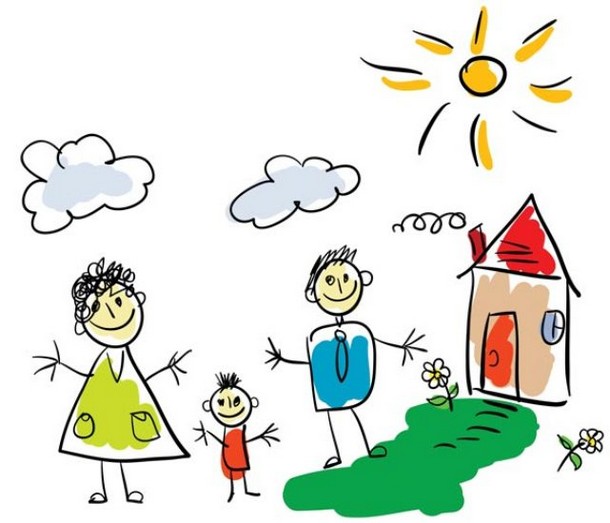What a child draws is just like an open window that sheds light into her inner world. Each drawing has its own journey which describes a child’s personality and behavior. Children’s drawings or scribbles or handwriting are an excellent opportunity for parents and educators to understand their mind and also help to improve their relations later on, once they are interpreted correctly.
The drawings give a vivid description of what a child goes through on emotional and social front every day. These drawings paint a clear picture of a child’s interpretation and experience. They can exactly tell us few things like-
· Social interaction at his/ her school/ classroom
· Emotional outbursts
· Hidden reasons behind their behaviours like anger, frustration, crying etc.
· Their relationship status with parents and siblings
· Eating, sleeping or toilet habits
· Personal traits like intelligence, confidence and talents etc.
· Academic performances
· Areas of interest
And after knowing this, we, as parents or educators, can try to find solutions of these problems.
Let’s try to find a rich and diverse world which a child transfers through her drawings:
1) Drawing, Child’s second language– drawings are considered as children’s second language, through which they throw some light on their character and critical events of their life. Though each child has his/her own personal style but the elements remain almost the same at a particular developmental stage. Drawings also provide a broad personality profile covering the performance in different areas of his/her life. Children’s drawings are an impressive and projective tool to understand his/her talents, emotional struggles, feelings and difficulties. However, it requires a systematic guidance and observance to reach to the conclusions carefully.
2) Examining Children’s Drawings- Exact analysis of the drawings is a complex process and requires a deep understanding of various aspects of child’s psyche. The first step involves figuring out the physical aspects of the drawings like; pressure of pencil or colour on the paper, direction of the movements, location, type and size of the drawings produced. The second step involves to developmentally comparing the drawings of the child to his/her peer group. This comprehensive analysis broadly describes a child’s emotional and social status, confidence levels, talents, insecurities, fears and behaviour patterns.
3) Scribbling- when we compare simple scribbles made by some children, we can clearly distinguish few things like; strong or light pressure on paper, round or vertical/diagonal scribble movements, covering full page or just a section of it, full unbroken lines or small broken lines etc. other indicators may include the style of lines ( straight, broken, slanting, spiral, thin, wavy, fragile, dark) and the way they intersect each other; how he/ she colours; geometric combination of scribbles; attention to details etc. the point is to figure out the muscular pressure applied on the pencil or crayon which is affected by cerebral activity and mind of the child. At this stage, children experience sensory stimulation by experimenting with colours, papers, textures and other materials. It is very important to provide with non toxic play material to children to develop their emotional, cognitive and fine motor skills. When the child draws something, he/she needs to maintain a balance between the movements towards the body and the movements away from the body. By the help of drawing processes, a child learns to control various body organs and movements related to them. This also leads to the decision making process for a child.
4) Developmental Stages and Drawing- when we observe a child’s drawings and scribbling for a long period, we will be actually able to judge his developmental phases (physical and mental). Growth pattern moves from general to specific and from gross motor or fine motor areas. So, if we closely observe the drawings we can notice the fine details that a child tries to add over a certain period of time. In an image we can clearly mark the difference after few months. The size of scribbles also grows smaller over a period since the movement travels from large limbs to small parts of hands. That is finger tips. The scribbles and drawings move from various stages like; spontaneous scribbling (1.5 to 2.5 years), structured scribbling(2.5 to 3.5 years), pre-schematic stage (3.5 to 4.5 years),schematic scribbling(5 years to 8 years), pre-realistic stage (8 years to 11 years), realistic stage (11years to 14 years).
5) Talents- children’s drawings are the real opportunity to go inside their minds and use them to understand what a child truly needs. These drawings are a reflection to their inner world and can be used to evaluate their feelings, needs, fears and talents etc. when a child draws for the first time, he/she starts out on an exciting journey. He/she expresses his inners self through his drawings at that time. So, while observing child’s drawing we should not emphasize what he drew, but how he drew it.
6) Social skills- children’s drawings highlight a very clear social development at that particular stage. It represents, their culture, choice of clothes, colours, family connections, sibling bonding, peer influence, school experiences etc. few tips like, closely drawn figures, choice of clothes, inter-relationship between the figures of the drawings etc can help to identify good social performance. Fear of strangers, bad experiences in early childhood or some accidents can be clearly seen in the pictures drawn by children. There are some signs which show difficulty in dealing with unwanted realities of life of a child. Social rejection could affect a child’s creativity and his confidence levels. He may lose interest in the drawing activity or will draw clumsy pictures with weak pressure.
